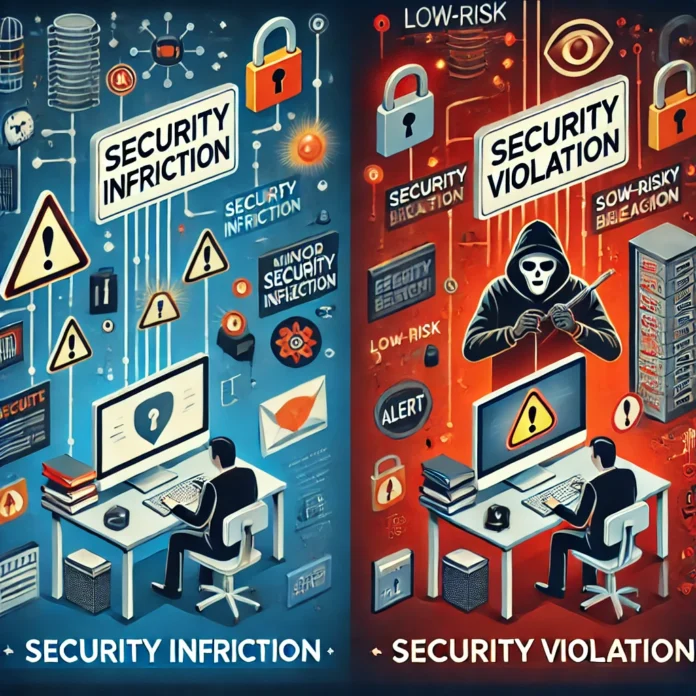Understanding the distinctions between a security infraction and a security violation plus the two terms’s respective punishments is of great importance for organizations and individuals dealing with sensitive information or working in controlled spaces. While both phrases pertain to violations of security procedures, the intent, severity, and consequences differ for each term.
What is a Security Infraction?
A security infraction is defined as a minor violative act that does not consist of unreasonable risk being posed to highly sensitive information. Infraction types include overstepping boundaries in predetermined policies and procedures. These types of infractions are often results of unintentional actions.
Examples of Security Infractions:
- Forgetting to log out from a workstation when leaving the desk.
- Leaving sensitive documents undestroyed during disposal.
- Leaving a badge or keycard in a secure vicinity without supervision.
- Sending an internal document to an external recipient by mistake.
Although these breaches of procedure are unlikely to jeopardize sensitive information, they do suggest carelessness on the part of the offender and if repeated can result in a need for stricter punitive measures.
What is a Security Violation?
A security violation, conversely, illustrates a deeper breach by ignoring set protocols or exposing sensitive information. Unlike infractions, these cases do not involve unintended erroneous behavior, but rather deliberate misconduct, great negligence, or failures of a serious nature.
Security violations include:
- Without permission, obtaining classified information watchdogs unaided.
- Deliberately conveying confidential information to a third person.
- Removing security protocols to obtain systems that are deemed off-limits.
- Physically displaying false credentials and bringing unapproved tools into a data secure setting.
Security breaches can have adverse effects such as career termination, litigation, or prosecution, depending on how severe the breach is.
Key Differences Between Security Infractions and Security Violations
The table below highlights the main differences:
| Aspect | Security Infraction | Security Violation |
| Severity | Minor | Major |
| Intent | Unintentional | Often intentional or grossly negligent |
| Examples | Forgetting to log out, leaving documents unsecured | Sharing classified information, bypassing security controls |
| Consequences | Warning, retraining, minor penalties | Legal action, job termination, criminal charges |
| Impact on Security | Minimal if addressed promptly | High risk of data loss or compromise |
Reputations and Legal Standing of the Organization
All security issues of a company internal and external are severe if they are repeating in nature and uncontrolled. Security violations can, however, lead to considerable financial losses, and legal procedures, and shrink the reputation of the business significantly.
How to Prevent Security Infractions and Violations
An organization attempting to create a safe environment must have extensive security policies and conduct training on a routine basis. The following are some recommendations:
- Regular Security Training: Keep employees apprised of crucial steps related to security procedures.
- Strict Access Control Measures: Allow sensitive information to be stored or retrieved based on the individual’s level of employment.
- Monitoring and Auditing: Perform regular audits focusing on security measures to assess where changes can be made.
- Clear Incident Reporting Mechanisms: Facilitate employees to express their concerns regarding safety measures without being victimized for it.
- Use of Secure Systems: Use encryption, multi-factor authentication, and other various modern-day technological enables.
Legal and Organizational Consequences
Security infractions and violations can result in grave legal and organizational consequences:
- For Individuals: Infractions may result in reprimands or retraining, while violations can lead to termination of employment or prosecution.
- For Organizations: Companies may bear regulatory sanctions fines, loss of loyalty, and reputational scars.
- For National Security: In governmental departments, violations of security may endanger state security and inordinate espionage.
FAQs
What happens if a security infraction is repeated?
Repeated offenses may reflect negligence, which may lead to the imposition of internal disciplinary measures such as formal warnings, revoke privileges, or suspensions in the hardest to deal with cases.
Can a violation stem from an infraction?
Yes. The loss or compromise of sensitive information in an infraction, as well as its circumvention through inaction, may classify it as a violation of security protocols.
Is every security violation committed with intent?
Not necessarily. Many security breaches of a less simple nature fall under the category of “gross negligence”, but they remain intent-driven. So, with intent, the consequence becomes severe as well.
What is the best way to manage security infringements by an organization?
An organization can do so by ensuring that there is proper training and awareness of the policies, systems, and structure in place when there is no regulation such as issuing reminders, instruction manuals, protocols, or documents.
How should one report a witness of a security violation?
Report it to your security officer or the compliance team. This enables risks to be mitigated quickly which eliminates the chance of further damage being inflicted on the organization’s structure.
Conclusion
Infraction of security protocols refers to lesser breaches that impede the operations of an organization, whereas violations of security protocols are actions where sensitive data is put at stake and thus have serious repercussions. Knowing how a security infraction differs from a security violation is pivotal for ensuring compliance as well as safeguarding delicate data. To counteract nullifying risks, organizations must adopt an all-encompassing strategy to conceal sensitive data and amplify guards against breaches.


